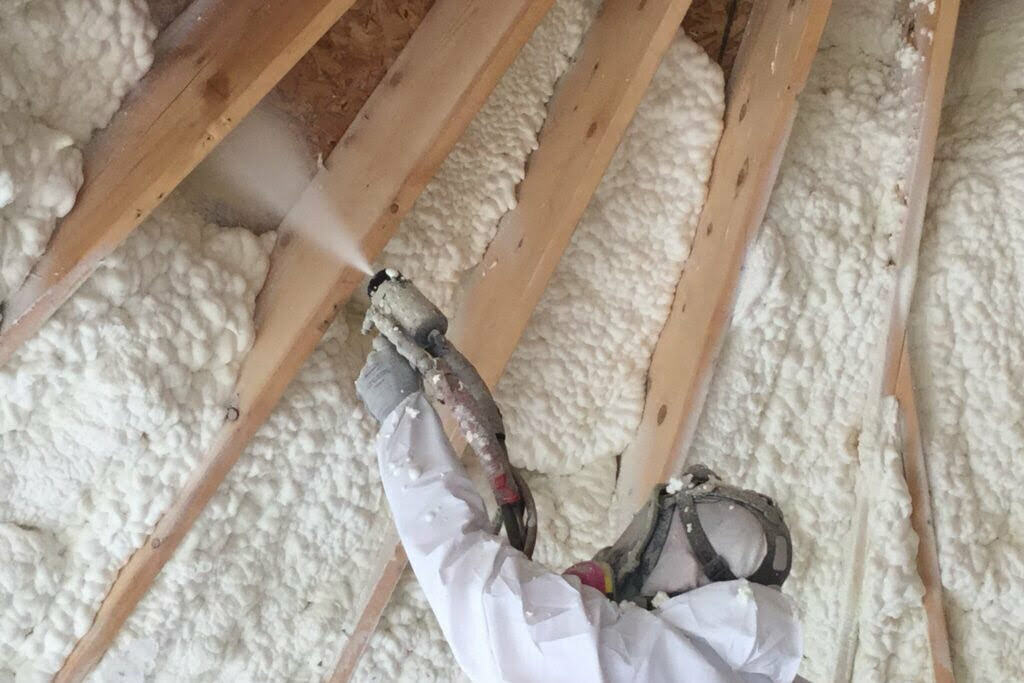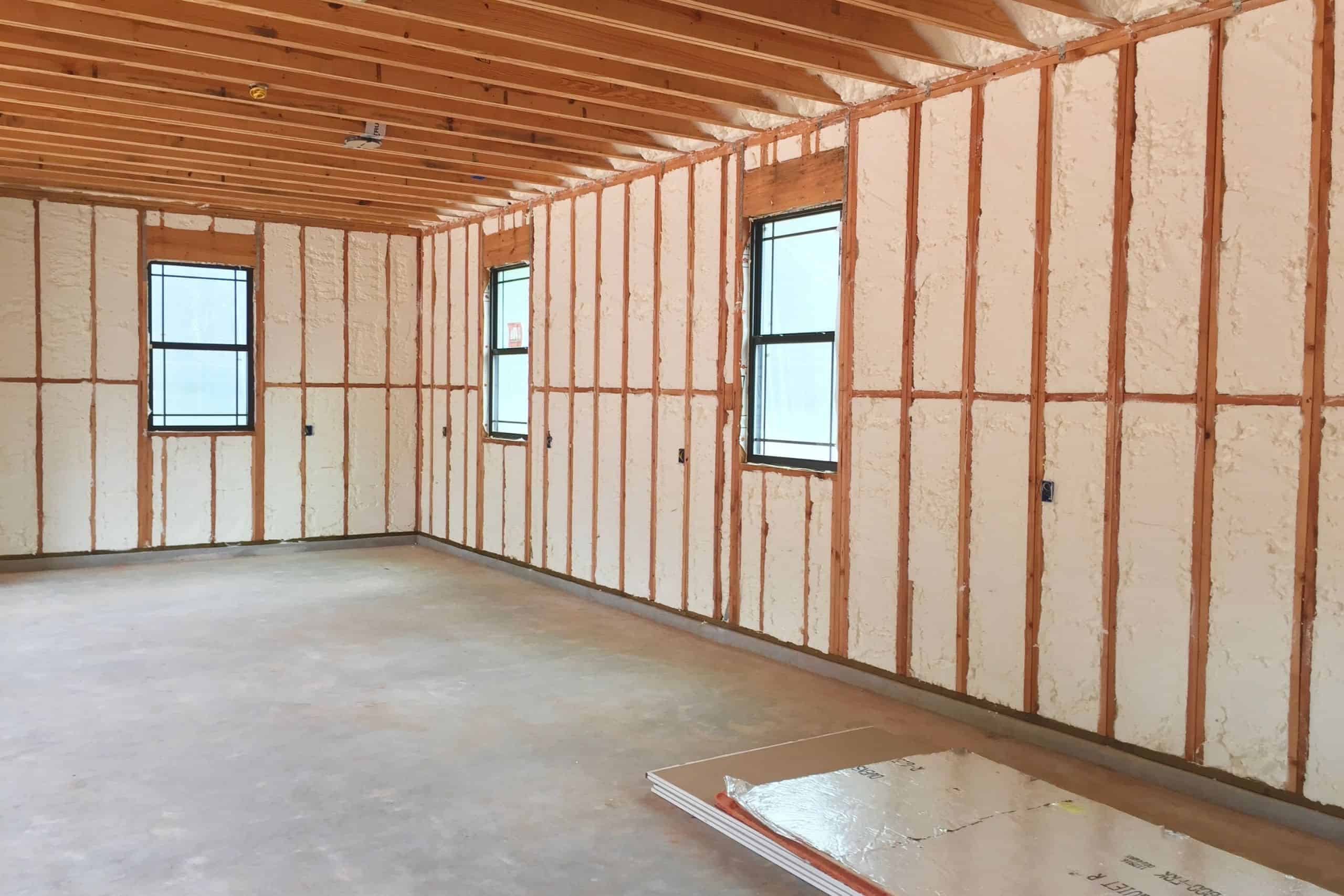Installing spray foam insulation inside interior walls can boost your home’s energy efficiency and comfort level dramatically. Let’s explore the benefits of upgrading with spray foam insulation, what you can expect from the interior wall spray foam insulation installation process, and why you should choose the experts at Cincinnati RetroFoam for your spray foam installation project.
Introduction to Spray Foam Insulation
Spray foam is a popular type of insulation that helps homes stay warm during winter and cool during the summer. The insulation is spread into wall cavities, and once installed, it creates a powerful barrier against heat loss.
Basics of Spray Foam Insulation
Spray foam insulation is applied by professionals using pressurized equipment to spray liquid polyurethane between structural members. As it cures, it expands into a rigid foam that insulates, seals cracks, and reduces air leaks. Spray foam insulation is often used in the construction or remodeling of a home to provide a high degree of insulation and form airtight seals.
Importance of Spray Foam Insulation for Interior Walls
Adding spray foam insulation to interior walls enhances efficiency by:
- Slowing heat transfer through the wall assembly
- Reducing airflow and infiltration through cracks and gaps
- Regulating humidity and condensation within the wall cavity
This allows homeowners to save on energy costs while making indoor temperatures more comfortable.
The Benefits of Installing Spray Foam Insulation
Having spray foam installed in your home comes with plenty of benefits. There are a few attractive advantages in particular that are sure to entice homeowners.
Energy Efficiency and Cost Savings
By insulating your walls with spray foam insulation, you can significantly reduce your high energy bills. The high R-value and air-sealing properties of spray foam prevent air from escaping, lowering heating and cooling demands. As a result of this greater energy efficiency, your HVAC system will have less strain, leading to fewer repairs or replacements over time. The reduction in energy usage also lightens the carbon footprint of your home.
Enhanced Indoor Comfort and Air Quality
Spray foam insulation seals off all potential air ingress points in your home, creating a comfortable indoor environment year-round, unaffected by outdoor conditions. By regulating temperature and humidity, it helps prevent issues like drafty rooms or cold spots.
Spray foam insulation also improves indoor air quality by preventing the entrance of allergens, dust, pollutants, and excess moisture into the home. Controlling humidity and sealing cracks inhibits the growth of mold, mildew, and dust mites.
Longevity and Durability of Spray Foam
When installed correctly following manufacturer specifications, spray foam insulation can last a lifetime without deterioration or sagging over time. This unmatched durability makes spray foam a cost-effective insulation solution in the long run, compared to other types of insulation that may degrade, settle, or allow air gaps over decades.
The Installation Process
Hiring professional spray foam installers like the experts at Cincinnati RetroFoam is the best way to ensure a successful insulation project. Their experience and expertise make a noticeable difference compared to DIY installation.
Safety Measures and Preparation
Professional installers undertake important preparations, including:
- Isolating the workspace and establishing proper ventilation flow to safely direct overspray away from the house. Plastic sheeting may be used as needed.
- Using proper PPE gear, including respirators, protective suits, gloves, and eye protection to shield themselves and occupants from exposure.
- Masking off any nearby surfaces like windows, trim, or finishes that should remain foam-free using masking tape and plastic.
- Sealing off any wall cavities or openings that will not be insulated at this time to contain the foam.
Professional Application Process
Trained contractors use specialized equipment to spray foam into open cavities that do not have drywall installed on them. They follow controlled procedures:
- Spraying and applying foam in layers, allowing proper expansion and cure time between passes.
- Trimming excess cured foam flush with the surface using serrated knives or saws.
Cleanup and Completion
Experienced installers complete the job professionally by:
- Allowing 24 hours for full curing before further work to prevent adhesion issues.
- Ventilating again to clear any residual odor from the curing process.
- Safely containing and disposing of excess cured foam and materials according to local regulations.
- Consulting on finishing steps like drywall replacement or painting.
Their expertise results in insulation that maximizes energy savings while blending seamlessly into the interior walls.
Benefits of Hiring a Professional Installer
A professional installer has the right training and equipment, can efficiently manage the installation process, and can insulate wall sections that may be difficult for the average DIYer. By hiring a reputable spray foam insulation service, you can avoid high energy bills that result from incorrectly installed insulation.
Professional installers will correctly seal and insulate existing walls by using specific tools. This ensures maximum energy efficiency, reducing your heating and cooling expenses and potentially lowering your overall energy bills.
Choosing the Right Installer: Tips and Considerations
When hiring a professional installer for spray foam insulation in your existing walls, consider their experience, customer reviews, and maintenance procedures post-installation. Be sure to also check if they are skilled to work with your specific insulation material and if they’re able to service the particular layout of your home.
Cost Implications: DIY Vs. Professional Installation
While DIY installation might seem cost-effective initially, the cost of spray foam insulation often turns out to be lower when professionally installed. The reason is that professionals calculate the exact material requirements, which prevents waste. They also follow correct installation protocols that prevent insulation failures, leading to savings in high energy bills in the long run.
Not to mention, professional installers may include cleanup and waste disposal as part of their service fee, helping save on post-installation costs. Their experience in handling spray foam also reduces the risk of costly mistakes or accidents during installation.
Interior Wall Spray Foam Insulation from Cincinnati RetroFoam
Cincinnati RetroFoam boosts home energy efficiency by expertly installing spray foam insulation into your home’s interior wall cavities. Our qualified team seals gaps and insulates walls using high-quality spray foam to meet your unique project needs. This long-lasting insulation solution provides enhanced performance and air quality compared to uninsulated walls. Cincinnati RetroFoam follows rigorous safety protocols and offers complete installation services. Contact us today to upgrade your interior walls with high-performing spray foam insulation applied by experienced professionals.
FAQs
How long does spray foam insulation let off gas after installation?
Any odors from curing should vanish within 24-48 hours with proper ventilation. Any residual gas smell typically clears within a few weeks at most.
Can you apply new spray foam over the old insulation?
It’s generally not recommended to apply new spray foam insulation directly over old insulation. The preferred method is to remove any existing insulation first and address any moisture or structural issues before installing new spray foam. However, in some cases, it may be acceptable to apply a new layer of spray foam over old insulation. Consult with a qualified spray foam insulation contractor to determine if over-spraying on existing insulation is appropriate for your specific project.
Is spray foam flammable after it is fully cured?
While still curing, spray foam is flammable and should be treated with caution. Once fully cured, spray polyurethane foam meets fire safety standards for building insulation.


